Related Research Articles

Assisi embroidery is a form of counted-thread embroidery based on an ancient Italian needlework tradition in which the background is filled with embroidery stitches and the main motifs are outlined but not stitched. The name is derived from the Italian town of Assisi where the modern form of the craft originated.

A quilt is a multi-layered textile, traditionally composed of three layers of fiber: a woven cloth top, a layer of batting or wadding, and a woven back, combined using the technique of quilting, the process of sewing the three layers together. The pattern of stitching can be the key decorative element if a single piece of fabric is used for the top of a quilt, but in many cases the top is pieced from a patchwork of smaller fabric pieces; and the pattern and color of these pieces will be important to the design.

Appliqué is ornamental needlework in which pieces or patch of fabric in different shapes and patterns are sewn or stuck onto a larger piece to form a picture or pattern. It is commonly used as decoration, especially on garments. The technique is accomplished either by hand stitching or machine. Appliqué is commonly practised with textiles, but the term may be applied to similar techniques used on different materials. In the context of ceramics, for example, an appliqué is a separate piece of clay added to the primary work, generally for the purpose of decoration.
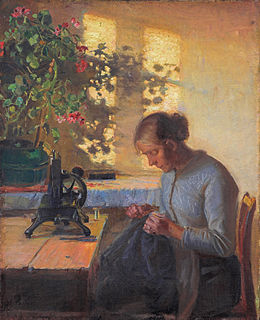
Sewing is the craft of fastening or attaching objects using stitches made with a needle and thread. Sewing is one of the oldest of the textile arts, arising in the Paleolithic era. Before the invention of spinning yarn or weaving fabric, archaeologists believe Stone Age people across Europe and Asia sewed fur and skin clothing using bone, antler or ivory needles and "thread" made of various animal body parts including sinew, catgut, and veins.

Bargello is a type of needlepoint embroidery consisting of upright flat stitches laid in a mathematical pattern to create motifs. The name originates from a series of chairs found in the Bargello palace in Florence, which have a "flame stitch" pattern.
Kantha is a type of embroidery craft in the eastern regions of the Indian subcontinent, specifically in Bangladesh and in the Indian states of West Bengal, Tripura and Odisha. In Odisha, old saris are stacked on each other and hand-stitched to make a thin piece of cushion. This is normally used above a bed cushion or instead of a cushion. "Kantha saris" are traditionally worn by women in Bengal region of the Indian subcontinent. In these days, embroidery is stitched, popularly known as 'kantha stitched", on sari, kurta and churidar and many other garments and gaining popularity due to their aesthetic value and handmade characteristics.
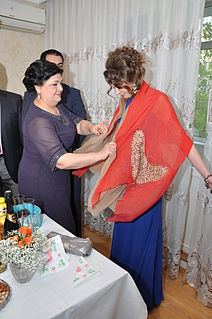
A shawl is an Indian simple item of clothing, loosely worn over the shoulders, upper body and arms, and sometimes also over the head. It is usually a rectangular or square piece of cloth, which is often folded to make a triangle, but can also be triangular in shape. Other shapes include oblong shawls.

Fiber art refers to fine art whose material consists of natural or synthetic fiber and other components, such as fabric or yarn. It focuses on the materials and on the manual labour on the part of the artist as part of the works' significance, and prioritizes aesthetic value over utility.

Phulkari refers to the folk embroidery of the Punjab. Although Phulkari means floral work, the designs include not only flowers but also cover motifs and geometrical shapes.The main characteristics of Phulkari embroidery are use of darn stitch on the wrong side of coarse cotton cloth with coloured silken thread. Punjabi women create innumerable alluring and interesting designs and patterns by their skilful manipulation of the darn stitch. According to Kehal (2009), a cloth where only a few flowers are embroidered is called a Phulkari. The other types are distinct varieties. The traditional varieties of Phulkaris are large items of cloth and include Chope, Tilpatr, Neelak and Bagh. Sometimes, the Bagh is given separate categorisation of its own as on other varieties of a Phulkari, parts of the cloth is visible, whereas in a Bagh, the embroidery covers the entire garment so that the base cloth is not visible. Further, in contemporary modern designs, simple and sparsely embroidered dupattas, odhinis, and shawls, made for everyday use, are referred to as Phulkaris, whereas clothing items that cover the entire body, made for special and ceremonial occasions such as weddings are called Baghs. The Phulkari continues to be an integral part of Punjabi weddings to the present day.
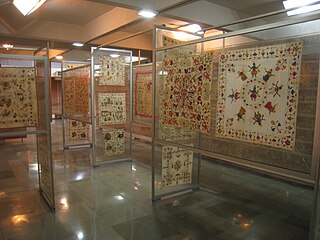
Embroidery in India includes dozens of embroidery styles that vary by region and clothing styles. Designs in Indian embroidery are formed on the basis of the texture and the design of the fabric and the stitch. The dot and the alternate dot, the circle, the square, the triangle, and permutations and combinations of these constitute the design.

African textiles are textiles from various locations across the African continent. Across Africa, there are many distinctive styles, techniques, dyeing methods, and decorative and functional purposes. These textiles hold cultural significance and also have significance as historical documents of African design.

Nakshi kantha, a type of embroidered quilt, is a centuries-old Bengali art tradition of the Bengal region, notable in Bangladesh and Indian states of West Bengal, Tripura and part of Assam. The basic material used is thread and old cloth. Nakshi kanthas are made throughout Bangladesh, but the greater Mymensingh, Jamalpur, Bogra, Rajshahi, Faridpur and Jessore areas are most famous for this craft.
Sewing is the craft of fastening or attaching objects using stitches made with needle and thread. Sewing is one of the oldest of the textile arts, arising in the Paleolithic Era. Although usually associated with clothing and household linens, sewing is used in a variety of crafts and industries, including shoemaking, upholstery, sailmaking, bookbinding and the manufacturing of some kinds of sporting goods. Sewing is the fundamental process underlying a variety of textile arts and crafts, including embroidery, tapestry, quilting, appliqué and patchwork.

Embroidery was an important art in the Islamic world from the beginning of Islam until the Industrial Revolution disrupted traditional ways of life.
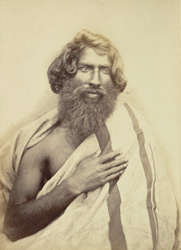
The Toda Embroidery, also locally known as "pukhoor", is an art work among the Toda pastoral people of Nilgiris, in Tamil Nadu, made exclusively by their women. The embroidery, which has a fine finish, appears like a woven cloth but is made with use of red and black threads with a white cotton cloth background. Both sides of the embroidered fabric are usable and the Toda people are proud of this heritage. Both men and women adorn themselves with the embroidered cloaks and shawls.
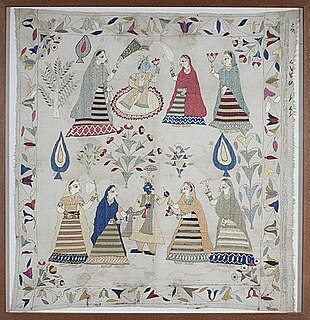
The Chamba Rumal or Chamba handkerchief is an embroidered handicraft that was once promoted under the patronage of the former rulers of Chamba kingdom. It is a common item of gift during marriages with detailed patterns in bright and pleasing colour schemes.

The Kutch Embroidery is a handicraft and textile signature art tradition of the tribal community of Kutch District in Gujarat, India. This embroidery with its rich designs has made a notable contribution to the Indian embroidery traditions. The embroidery, practiced normally by women is generally done on fabrics of cotton, in the form of a net using cotton or silk threads. In certain patterns, it is also crafted over silk and satin. The types of stitches adopted are “square chain, double buttonhole, pattern darning, running stitch, satin and straight stitches”. The signature effect of the colorful embroidery sparkles when small mirrors called abhla are sewn over the geometrically shaped designs. Depending on the tribal sub groups of Rabari, Garasia Jat, and Mutava involved with this craft work many hand embroidered ethnic styles have evolved. These six styles: Suf, khaarek, paako, Rabari, Garasia Jat, and Mutava.
Shaphee Lanphee is a traditional textile fabric woven and embroidered, usually as a shawl, with embroidered motifs with cotton threads generally by Meitei women of Manipur. The fabric was, in the past, presented as a gift of honour to the soldiers for their bravery in a successful war, and to the praise-worthy chiefs of the Nagas of Manipur by the king of Manipur. It is a product which is protected under the GI registration and is now made throughout the Indian state of Manipur.

Redwork is a form of American embroidery, also called art needlework, that developed in the 19th century and was particularly popular between 1855 and 1925. It traditionally uses red thread, chosen because red dyes were the first commercially available colorfast dyes, in the form of Turkey red embroidery floss. Redwork designs are composed of simple stitches and were mainly used to decorate household objects in the 19th and 20th centuries, especially quilts. Patterns for individual quilt blocks were sold for a penny in the United States, making them popular and affordable. In the 21st century, redwork has seen a resurgence among crafters. The main stitch used in redwork is backstitch or outline stitching, formerly known as Kensington stitch. Redwork was a common introductory form of embroidery taught to children in the 19th and 20th century. Children would make quilts decorated with redwork motifs, with motifs of various sizes prior to approximately 1910 and uniform sizes after that year. It was also a way for women with skills in pattern stamping or embroidery to generate their own source of income from the home.

Hedebo embroidery covers several forms of white embroidery which originated in the Hedebo (heathland) region of Zealand, Denmark, in the 1760s. The varied techniques which evolved over the next hundred years in the farming community were subsequently developed by the middle classes until around 1820. They were applied to articles of clothing such as collars and cuffs but were also used to decorate bed linen.
References
- 1 2 3 4 5 6 "Geographical Indications Journal No.18: Sujani Embroidery Work of Bihar" (pdf). Development Commissioner (Handcrafts), Ministry of Textiles. 1 June 2007. pp. 40–47. Archived (PDF) from the original on 10 August 2013. Retrieved 18 May 2016.
- 1 2 3 4 5 6 "Craft Cluster: Sujini Embroidery" (pdf). National Institute of Fashion Technology. Archived (PDF) from the original on 18 April 2016. Retrieved 18 May 2016.
- ↑ "Statewise Break up of Indian GI Registered Applications till December 15, 2014" (pdf). National Informatics Center. Archived (PDF) from the original on 11 June 2016. Retrieved 18 May 2016.
- ↑ "Sujni Embroidery" (pdf). Craftwork organization. Archived (PDF) from the original on 5 June 2016. Retrieved 18 May 2016.